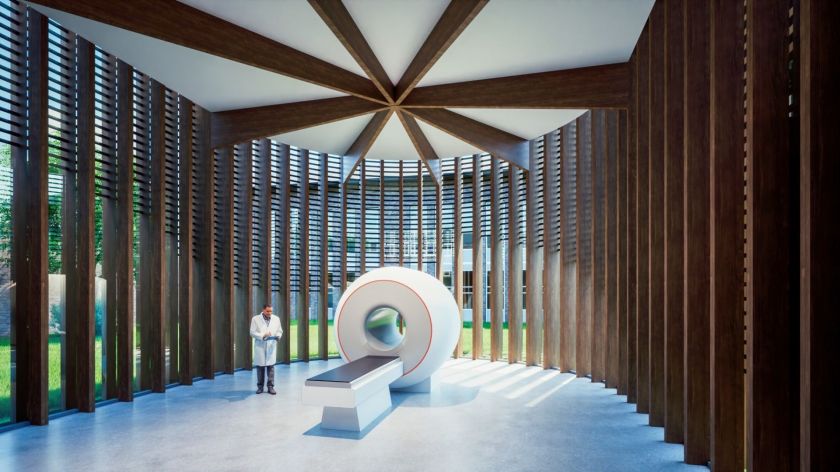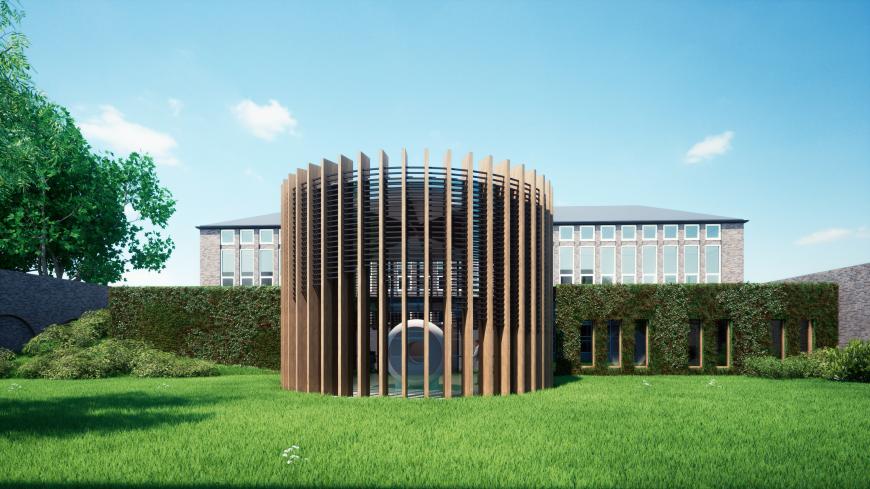Nijmegen super scanner will soon produce the sharpest brain images ever: how can it be of service to science?
-
 Artist impression: Croonen Architecten
Artist impression: Croonen Architecten
Together with six Dutch partners, the Donders Institute is preparing to build the world’s strongest MRI scanner in Nijmegen. The super scanner will allow for unprecedentedly detailed brain imaging, but can test subjects handle such a strong magnetic field?
It was such big news that it even made the eight o’clock news: Nijmegen will soon be home to the world’s strongest MRI scanner. The Dutch Research Council (NWO) is contributing 19 million euros to the project from its ‘National Roadmap’ grant programme. This programme is intended for important and expensive research equipment, such as components for space telescopes, for example. ‘This scanner will soon place Nijmegen at the centre of the world in the field of neuroimaging,’ says research leader David Norris (Donders Institute) proudly. ‘It will make Nijmegen even more attractive to leading international scientists.
‘Thanks to this scanner, we will soon also be able to identify very small brain nuclei’
The device will have a strength of no less than 14 Tesla – a strength never seen before in research on humans. Tesla is the unit of measurement for magnetic strength (and has nothing to do with the car brand). By comparison, the Earth’s magnetic field, to which a compass needle responds, is less than one ten-thousandth of a Tesla.
The new Nijmegen scanner will be almost five times more powerful than the modern 3 Tesla MRI scanners that are now used in many hospitals, and more powerful than any existing scanners used in brain research. The current record holders are Paris and Baltimore, which currently have two 11.7 Tesla MRI scanners.
Impressive performance
What exactly can we expect from this scanner, which, if all goes well, will be switched on for the first time in three years’ time? Norris does not have to think long about the answer, as he explains in his office in the Trigon building. The Professor of MRI Physics shows us one artist’s impression after another, as well as all the impressive results expected by the DYNAMIC consortium (see box). ‘We will soon be able to make much better scans that can distinguish details as small as 0.3 millimetres. The current Nijmegen scanners can barely manage 0.8 millimetres,’ he says. ‘Thanks to this scanner, we will soon be able to identify very small brain nuclei.’
The scanner will also make it possible to distinguish the different layers of grey matter (the neurons in the outer layer of the brain), says the Professor, and to see how information is exchanged within them. Previously, such experiments were done primarily with laboratory animals. ‘These layers can already be distinguished using today’s powerful 7 Tesla scanners, but not with this kind of precision.’ In addition, the scanning time required is much shorter with 14 Tesla, which will enable studies that may at present be too long for test subjects.
What’s more, entirely new research opportunities will emerge, such as measuring the amount of neurotransmitters, the messenger substances in our brain. Norris: ‘The scanner will allow us to see some of these neurotransmitters in 18 times more detail than with 7 Tesla.’ This provides opportunities to better understand exactly what goes wrong in diseases involving these substances, such as depression and Parkinson’s disease.
DYNAMIC
The new scanner may be located in Nijmegen, but it will clearly be a national research facility, Norris stresses. ‘Anyone can come here and use the scanner.’ Seven Dutch research institutes are involved in this DYNAMIC consortium. In addition to Radboud University and Radboud university medical center, these include the UMCs of Amsterdam, Leiden and Utrecht, Maastricht University, and the Amsterdam Spinoza Centre for Neuroimaging. Norris: ‘Our areas of expertise are highly complementary. Utrecht, for example, has a lot of knowledge of hardware development, while we are good at developing scanning techniques. This is quite a challenge with high field strengths.’
All this may sound very promising, but this kind of very strong magnetic strength does pose all sorts of practical challenges. Current super scanners of 10 Tesla or more suffer from all sorts of problems, despite up to a decade of tinkering at times. So far, very little actual research has been done on human subjects using these scanners.
For example, researchers in Baltimore have worked for years to fix their 11.7 Tesla super scanner after it inadvertently heated up during initial tests. MRI scanners are cooled with liquid helium to a fraction above absolute zero (273 degrees Celsius below zero), because it is only at this temperature that the electric wires develop superconducting properties. This is necessary to create the magnetic field. The equally powerful scanner in Paris has been under construction for a decade, and so far has only produced test images of the inside of a pumpkin.
Maximum limit shifted
Is it actually a good idea to build an even stronger MRI device, when the current top scanners already experience so many problems? It most certainly is, says Norris. In fact, the Nijmegen scanner will be technically quite different from current devices. ‘With the superconducting material traditionally used, you can theoretically go up to a maximum of 12 Tesla. Current high field scanners (with high magnetic field strength, Eds.) come very close to that, which is why they have so many technical problems.’
‘I predict that the first person to go in will come out puking’
In the Nijmegen variant, the theoretical maximum limit is much higher, at 28 Tesla, so the scanner is nowhere close to being pushed to its limit. And the materials also require less extreme cooling. Therefore, there is no need for helium (which can be difficult to obtain), and the scanner will be cooled using a vacuum. An added advantage is that the scanner will be a lot more compact than current super scanners, with a wide opening for test subjects – nice for people who are a bit claustrophobic.
Fairground attraction
There are also some concerns about what this type of scanner will do to test subjects. ‘I predict that the first person to go in will come out puking,’ says John van Opstal in a decisive tone in his office at the Huygens building. The reason for this, as the Professor of Biophysics (Donders Institute) explains, is that strong magnetic fields stimulate the balance organ, similarly to a fairground ride. ‘You’ll feel as if you’re constantly spinning.’ Van Opstal has studied the functioning of the balance organ located in our inner ear for decades.
At relatively low magnetic field strengths like 3 Tesla, the stimulating effect is relatively small, but it becomes quite noticeable already at 7 Tesla. Van Opstal plays a video showing a close-up shot of the eye of a test subject in a 7 Tesla MRI scanner. The eye is continuously moving back and forth. This phenomenon, known as nystagmus, is an automatic eye reflex that occurs when you spin around.
Float
Van Opstal: ‘At 14 Tesla, this effect will get even worse. The effects may even be harmful at that point – nobody knows.’ For example, ear stones may come loose in the otoliths (a part of the balance organ), he says. This leads to a form of vertigo that could last for weeks. The question is also whether the scanner can trigger what is known as paramagnetic effects – a phenomenon that makes things float. This is something that occurs at extreme magnetic strengths, such as those of the 37.5 Tesla scanner at HFML-FELIX (not suitable for humans) used by Nijmegen physicists in 1997 to make a frog float. Test subjects will not float in the new scanner, but small things in their bodies might, Van Opstal speculates.
‘We take safety very seriously’
Norris stresses that he and his colleagues are being very careful. ‘We take safety very seriously,’ he says. ‘We know from other strong scanners that there may be some short-term effects, including dizziness. We will only do research on test subjects once all these aspects have been thoroughly investigated. Moreover, there will be an independent safety committee to review everything. And we’re working closely with the Paris team and other labs to learn from their experiences with super scanners.’ He does not expect to see floating effects. And should it really be necessary, he says, the magnetic strength can always be lowered. In other words, whatever happens, the multimillion-euro investment will certainly not be a waste of money.
Dizziness
Professor of Radiology Thijs van Osch (Leiden University Medical Centre) does not expect any insurmountable problems either. Van Osch, who is also involved in the DYNAMIC consortium, repeatedly investigated the risks of scanning at high field strengths. For example, in 2013, he analysed the experiences of over one hundred test subjects with the powerful Leiden 7 Tesla scanner. ‘The results were not too bad. One third of the subjects suffered from dizziness, but mostly at the moment when they entered the scanner,’ he explains over the telephone. ‘You can reduce this effect substantially by sliding people in very slowly.’
In addition, an equally large group found the loud scanner noise uncomfortable (despite wearing hearing protection). Only 3 percent found the scanning session really unpleasant overall. Van Osch: ‘In practice, most people get used to it after about 10 minutes. I therefore do not expect 14 Tesla to pose any problems.’
It will probably take another ten years before we have a clear idea of how the Donders Institute’s new acquisition turns out. The plan is that by that time, the scanner will be fully tested and running at full capacity in medical and brain research. Norris, with a laugh: ‘It will keep me busy until I retire.’
Translated by Radboud in’to Languages




